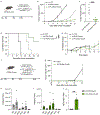Carbohydrate-Lectin Interactions Reprogram Dendritic Cells to Promote Type 1 Anti-Tumor Immunity
- PMID: 39283240
- PMCID: PMC11646345
- DOI: 10.1021/acsnano.4c07360
Carbohydrate-Lectin Interactions Reprogram Dendritic Cells to Promote Type 1 Anti-Tumor Immunity
Abstract
Cancer vaccine development is inhibited by a lack of strategies for directing dendritic cell (DC) induction of effective tumor-specific cellular immunity. Pathogen engagement of DC lectins and toll-like receptors (TLRs) is thought to shape immunity by directing T cell function. Controlling downstream responses, however, remains a major challenge. A critical goal in advancing vaccine development involves the identification of receptors that drive type 1 cellular immunity. The immune system monitors cells for aberrant glycosylation (a sign of a foreign entity), but potent activation occurs when a second signal, such as single-stranded RNA or lipopolysaccharide, is present to activate TLR signaling. To exploit dual signaling, we engineered a glycan-costumed virus-like particle (VLP) vaccine that displays a DC-SIGN-selective aryl mannose ligand and encapsulates TLR7 agonists. These VLPs deliver programmable peptide antigens to induce robust DC activation and type 1 cellular immunity. In contrast, VLPs lacking this critical DC-SIGN ligand promoted DC-mediated humoral immunity, offering limited tumor control. Vaccination with glycan-costumed VLPs generated tumor antigen-specific Th1 CD4+ and CD8+ T cells that infiltrated solid tumors, significantly inhibiting tumor growth in a murine melanoma model. The tailored VLPs also afforded protection against the reintroduction of tumor cells. Thus, DC lectin-driven immune reprogramming, combined with the modular programmability of VLP platforms, provides a promising framework for directing cellular immunity to advance cancer immunotherapies and vaccines.
Keywords: antitumor; dendritic cell; immunotherapy; lectin; toll-like receptor; virus-like particles.
Conflict of interest statement
A.K.S. reports compensation for consulting and/or Scientific Advisory Board (SAB) membership from Merck, Honeycomb Biotechnologies, Cellarity, Repertoire Immune Medicines, Hovione, Third Rock Ventures, Ochre Bio, FL82, Empress Therapeutics, Relation Therapeutics, Senda Biosciences, IntrECate biotherapeutics, Santa Ana Bio, and Dahlia Biosciences unrelated to this work. D.J.I. reports compensation for consulting and/or SAB membership from Elicio Therapeutics, Ankyra Therapeutics, Strand Therapeutics, Window Therapeutics, Venn Therapeutics, Alloy Therapeutics, Livzon Pharmaceuticals, SQZ Biotechnologies, Jupiter Therapeutics, Parallel Bio, Surge Therapeutics, Senda Biosciences, Gensaic Therapeutics, and Third Rock Ventures unrelated to this research. J.A.J. is a cofounder and shareholder of Window Therapeutics unrelated to this research. L.L.K. reports compensation for consulting and/or SAB membership from Exo Therapeutics, the ONO Pharmaceutical Foundation, and Coca Cola unrelated to this research. V.L., R.H., M.M.A., L.L.K., and M.G.F. are inventors on relevant patent applications held by the Massachusetts Institute of Technology and Georgia Institute of Technology. The remaining authors declare that they have no competing interests.
Figures






References
Publication types
MeSH terms
Substances
Grants and funding
LinkOut - more resources
Full Text Sources
Molecular Biology Databases
Research Materials

